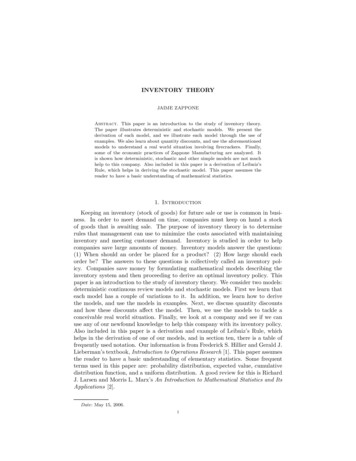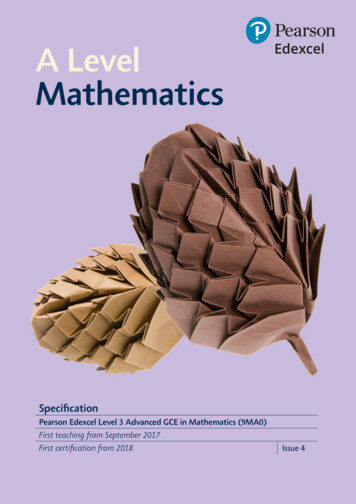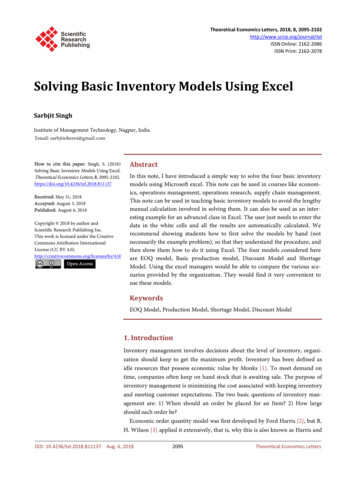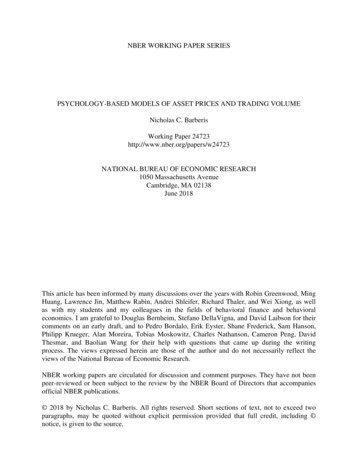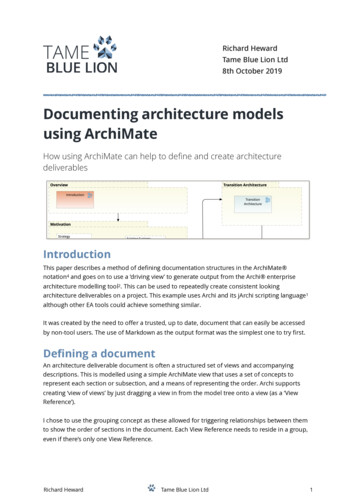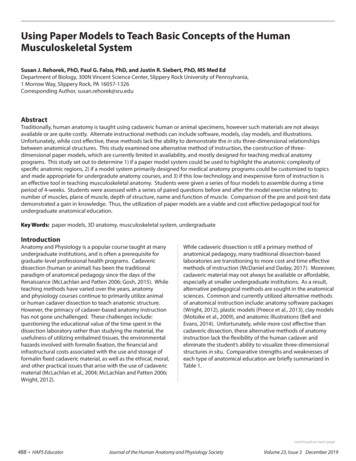
Transcription
Using Paper Models to Teach Basic Concepts of the HumanMusculoskeletal SystemSusan J. Rehorek, PhD, Paul G. Falso, PhD, and Justin R. Siebert, PhD, MS Med EdDepartment of Biology, 300N Vincent Science Center, Slippery Rock University of Pennsylvania,1 Morrow Way, Slippery Rock, PA 16057-1326Corresponding Author, susan.rehorek@sru.eduAbstractTraditionally, human anatomy is taught using cadaveric human or animal specimens, however such materials are not alwaysavailable or are quite costly. Alternate instructional methods can include software, models, clay models, and illustrations.Unfortunately, while cost effective, these methods lack the ability to demonstrate the in situ three-dimensional relationshipsbetween anatomical structures. This study examined one alternative method of instruction, the construction of threedimensional paper models, which are currently limited in availability, and mostly designed for teaching medical anatomyprograms. This study set out to determine 1) if a paper model system could be used to highlight the anatomic complexity ofspecific anatomic regions, 2) if a model system primarily designed for medical anatomy programs could be customized to topicsand made appropriate for undergradute anatomy courses, and 3) if this low-technology and inexpensive form of instruction isan effective tool in teaching musculoskeletal anatomy. Students were given a series of four models to assemble during a timeperiod of 4-weeks. Students were assessed with a series of paired questions before and after the model exercise relating to:number of muscles, plane of muscle, depth of structure, name and function of muscle. Comparison of the pre and post-test datademonstrated a gain in knowledge. Thus, the utilization of paper models are a viable and cost effective pedagogical tool forundergraduate anatomical education.Key Words: paper models, 3D anatomy, musculoskeletal system, undergraduateIntroductionAnatomy and Physiology is a popular course taught at manyundergraduate institutions, and is often a prerequisite forgraduate-level professional health programs. Cadavericdissection (human or animal) has been the traditionalparadigm of anatomical pedagogy since the days of theRenaissance (McLachlan and Patten 2006; Gosh, 2015). Whileteaching methods have varied over the years, anatomyand physiology courses continue to primarily utilize animalor human cadaver dissection to teach anatomic structure.However, the primacy of cadaver-based anatomy instructionhas not gone unchallenged. These challenges include:questioning the educational value of the time spent in thedissection laboratory rather than studying the material, theusefulness of utilizing embalmed tissues, the environmentalhazards involved with formalin fixation, the financial andinfrastructural costs associated with the use and storage offormalin fixed cadaveric material, as well as the ethical, moral,and other practical issues that arise with the use of cadavericmaterial (McLachlan et al., 2004; McLachlan and Patten 2006;Wright, 2012).While cadaveric dissection is still a primary method ofanatomical pedagogy, many traditional dissection-basedlaboratories are transitioning to more cost and time effectivemethods of instruction (McDaniel and Daday, 2017). Moreover,cadaveric material may not always be available or affordable,especially at smaller undergraduate institutions. As a result,alternative pedagogical methods are sought in the anatomicalsciences. Common and currently utilized alternative methodsof anatomical instruction include: anatomy software packages(Wright, 2012), plastic models (Preece et al., 2013), clay models(Motoike et al., 2009), and anatomic illustrations (Bell andEvans, 2014). Unfortunately, while more cost effective thancadaveric dissection, these alternative methods of anatomyinstruction lack the flexibility of the human cadaver andeliminate the student’s ability to visualize three-dimensionalstructures in situ. Comparative strengths and weaknesses ofeach type of anatomical education are briefly summarized inTable 1.continued on next page488 HAPS EducatorJournal of the Human Anatomy and Physiology Society Volume 23, Issue 3 December 2019
Using Paper Models to Teach Basic Concepts of the Human Musculoskeletal SystemMethodCadavericdissectionClay modelsStrengthWeaknessDissection SkillsRequires low student to faculty ratioActive form of LearningDissection is time intensiveExposure to a vertebrate bodyEnvironmental Hazards3D relationships easily observedCost Intensive to InstitutionsAnatomic variation is appreciatedEthical and Moral issues3D structureIntensive training of faculty and studentsStudents make their own bodyRequires low student to faculty ratioHighly interactiveRequires self-motivated studentsArtistic stylization of anatomyAllows for easy to identify coloration, and isolation of structuresIllustrationsCan show depth with multiple illustrationsRelatively inexpensiveIllustrations may be incorrectCopyright/legal issuesLoss of 3D visualization & relationshipsLoss of anatomic variationEasy to studyPlastic modelsPassive form of learningEasy to handleExpensive3D structuresLoss of associations between muscles and bonesCan enlarge structures too small to adequatelystudy in situCannot show deep musclesModel Keys may be incorrectEasy to studyArtistic stylization of anatomyInteractive (depending on the model)Loss of anatomic variationExpensive programsSoftwareUses technologyAccess to Computer TechnologyCan be accessed outside class roomLoss of 3D visualization & relationshipsReal time quizzingLimited interaction with specimensInteractive programsTechnological ability of FacultyLoss of anatomic variationTable 1. Current Utilized Methods of Anatomic InstructionThere is an additional method of instruction for anatomyeducation, which is the construction and use of threedimensional paper models. Paper model systems currentlyexist. However these models are designed specifically formedical students, include complex details, and require readinga complicated set of instructions in order to assemble themodel (Weber, 1979; Locket et al., 2012). In undergraduateintroductory level courses where students have limitedcourse time to devote to anatomical descriptions, limitedresources, and variable levels of pre-requisites, the utilizationof the current paper model system would be inappropriate.However, the utilization of a paper model system is intriguingbecause it can address several of the previously mentionedweaknesses presented by other forms of anatomicalinstruction. First, because it is a paper model, it is inexpensiveand pre-prepared. Second, because it allows for the study ofanatomic structures at different layers and depths, it generallypreserves the three-dimensional relationships betweenvarious anatomic structures. Third, the students have toassemble the paper models, resulting in an active hands-oninteractive learning activity. Finally, because this is a papermodel system there are no ethical concerns, environmentalhazards, or need for expensive technological or otherinstitutional infrastructure.continued on next page489 HAPS EducatorJournal of the Human Anatomy and Physiology Society Volume 23, Issue 3 December 2019
Using Paper Models to Teach Basic Concepts of the Human Musculoskeletal SystemTo address the need for alternate instruction methods, in thisstudy we set out to investigate three primary questions:1. Could the paper model system effectively highlightand teach the complexity of he musculoskeletalsystem for four different regions of the human body?2. Could a paper model system designed to teachmedical students be adapted to a complexity levelappropriate for undergraduate students?3. Could this inexpensive, low tech, hands-on modelsystem achieve a significant gain in student learningon a complex topic like the musculoskeletal system?This study also investigated whether specific demographics(major, SAT score, etc) had an impact on the effectiveness ofthis teaching tool.Materials and MethodsThe research protocol (protocol # 2016-045-17-A) for this studywas submitted to the Slippery Rock University InstitutionalReview Board. It was determined to be exempt for therequirement for IRB review and approval, per exemptionaccording to 45 CFR 46.101(b)(1) for research conducted inestablished education settings involving normal educationpractices such as research on the effectiveness of curricula.PopulationThe paper model system was tested on six sections of Biology217, Anatomy and Physiology II, at Slippery Rock University fora total sample size of 140 students. As illustrated in Figure 1A,the vast majority of students, 76.43%, were female. As shownin Figure 1B, a majority of the students, 48.57%, had declaredexercise science as their major, while 45% of the studentswere public health majors. The remaining 6.43% of studentswere other declared majors such as biology, histotechnology,and cytotechnology. The class year of students varied fromFigure 1. Demographic data of the anatomy and physiology IIclass. The demographic break down of the student population inthe Biology 217: Anatomy and Physiology with Lab II course. (A)The percent of students by identified gender. (B) The percentageof student in declared majors. ES exercise science, PH publichealth, Other students enrolled in the biology major, or oneof the many pre-health profession programs (e.g. biology,histotechnology, and cytotechnology).underclassmen to upperclassmen, and included students whowere first-experience students as well as course-repeatingstudents. Students SAT scores were acquired through theoffice of institutional research.Paper ModelsFour different regions of the human body, the abdomen,brachium, face, and anterior thigh, were studied over a fourweek period during one semester. The paper models usedin this study were derived from two different sources. Papermodels for the brachium and anterior thigh were from Locketet al. (2012). The nerves and arteries of the two paper modelsystems were omitted from this study. Since the brachiumand anterior thigh models were originally designed to teachanatomy at a medical school level, they were developed tobe anatomically proportional, contain a high degree of finedetail, and be accompanied by a complex set of assemblyinstructions. Moreover, due to the fine level of anatomic detail,the names of the muscles were written on the paper adjacentto the pieces of the model, that were eventually to be cut out(Locket et al. 2012).Models for the abdomen and face, although inspired by theLocket et al. (2012) paper model system, were created byone of the authors (S. Rehorek) and specifically designed forundergraduate level instruction. Thus, the S. Rehorek modelswere intentionally designed to be simple and clear with lessconcern for anatomic proportionality and a lesser degreeof fine detail. They included a set of assembly instructionsthat were simple and easy to follow. More importantly, thenames of the muscles were either written on the modelpieces (abdominal model), or the muscle abbreviations werewritten on the models pieces (face model). Each set of modelsincluded a key to the abbreviations in the model activitypacket. Models were printed on normal weight copy paper,left uncolored, and an instruction sheet on model assemblywas provided. Lines indicating muscle fiber directionality weresketched on all of the models.Figure 2. The abdominal muscles model. This partiallydeconstructed picture of the model components shows theelements used and the simplicity of the design.continued on next page490 HAPS EducatorJournal of the Human Anatomy and Physiology Society Volume 23, Issue 3 December 2019
Using Paper Models to Teach Basic Concepts of the Human Musculoskeletal SystemActivityDuring the musculoskeletal portion of the course, studentswere given one of the four different paper models (abdomen,brachium, face, or anterior thigh) based upon the specific bodyregion being covered that week. Students were given a packetthat included the pieces of the paper model and the instructionsheet, along with the scissors and glue sticks necessary tocomplete the activity. Students were then instructed to colorthe individual pieces of the paper model for easy identificationand to follow the instructions for cutting out the individualpieces of the model. The instructions for assembling themodels were given after the students had cut out the pieces ofthe model. A completed model was available for students toobserve. Students were given an hour to complete constructionof the model. Students were asked to compare their newlyconstructed three-dimensional paper model to the plasticanatomical models available in the anatomy lab.Assessment of KnowledgePrior to the beginning of the musculoskeletal unit in theAnatomy and Physiology II course, students were given apre-test to assess their base knowledge. The scored pre-testswere not returned to students, and the correct answers to thepre-test questions were not reviewed or discussed, so thatstudents could not memorize the questions and answers. Theassessment of base anatomical knowledge was done becausestudents majoring in exercise science had already takenan introductory musculoskeletal anatomy course, whereasstudents majoring in public health and the other majors hadnot. Following the conclusion of the study of each bodyregion in class, student knowledge was again assessed on eachof the body regions, using the same pre-test questions. Asshown in Table 2, the assessment questions were designed tocover five basic areas of knowledge:1. The number of muscles learned.2. The names of structures.3. The function of structures.4. The plane of the muscles.5. The depth of the structures.All tests, pre and post, consisted of five multiple choice questions,and were therefore graded and reported out of five points.Assessment of Student ConfidenceA total of three questions were designed to determinestudent confidence in their own knowledge of the material.Confidence was assessed for the abdomen, brachium, andface utilizing a Likert scale of 1 to 5, with 1 designated as notconfident, and 5 designated as very confident. As indicatedin Table 3, the three questions assessed ability to identifymuscles, ability to understand the layering of the muscle,and the ability to connect the structure of the muscle to itsfunction. Unfortunately, because of the timing of the labactivities in the semester, confidence data for the anteriorthigh could not be assessed because the post-test items forthis anatomic region were covered on the final exam, and notavailable for inclusion in this study.Topic of questionRationale for questionsExample questionNumber of musclesTo test to see if students understand that there are multiple muscles inany given regionHow many pairs of abdominal muscles arethere?Plane of muscleTo test to see if students understand that muscle fibers are orientated ina specific mannerThe fibers of which muscle areperpendicular to the sagittal plane?DepthTo see if students understand that muscles are arranged in a 3D mannerWhich muscle is the deepest?Name of structureTo see if students understand that muscles are associated with namesand structures.Which muscle forms part of the radialgroove?Muscle functionTo see if students understand the function of a given muscleWhich muscle causes hip flexion?Table 2. Topic Questions Designed to Test Anatomic KnowledgeTopic of questionRationale for questionQuestion askedRegional MuscleidentityTo determine student perception of regional muscle identityconfidenceHow confident do you feel about beingable to identify facial/abdominal or armmuscles?LayeringTo determine if students understood that muscles are layeredHow confident do you feel aboutunderstanding the different layers ofmuscles?Connecting structureto functionTo determine if students understand that muscle fibers orientationdictates muscle functionHow confident do you feel aboutunderstanding the role of planes in musclefunction?Table 3. Questions Designed to Assess Confidence of Student’s Knowledge491 HAPS EducatorJournal of the Human Anatomy and Physiology Societycontinued on next page Volume 23, Issue 3 December 2019
Using Paper Models to Teach Basic Concepts of the Human Musculoskeletal SystemTopic of questionRational for questionQuestion askedHelpfulness of papermodel activityTo determine if the students felt this approachenhanced their learning experienceI found the use of paper models helpedme learn the muscles of the bodyMost Helpful ModelTo determine student preference of specific modelsI found to be the most helpfulLeast Helpful ModelTo determine student preference of specific modelsI found to be the lest helpfulTable 4. Questions Designed to Assess Student Perception of the Paper Model ActivityStudent Perception of the Paper ModelsAt the end of the semester, as part of the student courseevaluation process, students were asked three questionsdesigned to assess the student perception of the paper modelactivity. The student course evaluation process is anonymousso the responses to the questions regarding studentperception of the paper model activities could not be used toidentity individual students or cohorts. As seen in Table 4, thequestions assessed whether the students liked the activity,which model the student found to be the most helpful, andwhich model the student found to be the least helpful.model systems demonstrated the largest learning gain, thedifference between pre and post-test results was analyzedusing a Kruskal-Wallis one-way analysis of variance on ranks.Overall, a significant (P 0.001) difference in student learninggain was observed between the different anatomical modelsystems. Tukey post hoc testing revealed no difference whencomparing the learning gain between the two Locket modelsData AnalysisAll the data were analyzed using SigmaPlot 13.0. Thesignificance for all tests was determined to at least a P-value of 0.05. The specifics of each statistical analysis can be found inthe results and analysis section.Results and AnalysisStudents demonstrated an overall gain of knowledge utilizing thepaper model systemOne of the main objectives of this study was to determine if apaper model system initially designed for students in a medicalanatomy program could be appropriately customized and usedto teach anatomy in an undergraduate setting. To determinethe effectiveness of the paper models as a teaching tool,students were given a pretest to assess their base knowledgeprior to building and studying the paper model and a posttest following construction and studying of the paper model.Student performance on the post-tests was compared todetermine on which post-test students performed the best.First the post-test for the four different paper models wereanalyzed using the Kruskal-Wallis one-way analysis of variance.This analysis showed a significant (P 0.001) difference betweenthe results of the post-tests. Further post-hoc testing revealedthat the students’ post-test performance on the abdomen wassignificantly better than their post-test performance on any ofthe other anatomical regions. Post-hoc testing did not find anysignificant post-test performance difference between the face,brachium, or anterior thigh anatomic regions.Analysis of the pre and post-test data began with theShapiro-Wilk test for normality, which generated a value ofP 0.05, indicating that the data was not normally distributed.Therefore, the data was analyzed utilizing the Wilcoxonsigned rank test, revealing a significant (P 0.001; Figure 3a)difference between the pre and post-test data for all four ofthe models studied. In order to determine which of the paperFigure 3. Pre and post-test performance on anatomicalknowledge questions. (A) Student acquisition of knowledge wasassessed using a series of pre-test questions, administered priorto using a paper model, and a post-test following using a papermodel. Pre-and-post-test results were reported out of a score offive. (B) The learning gain was determined by taking the post-testscore and subtracting the pre-test score to determine the overalldifference. The gain in student learning was then comparedbetween the different model activities. Error Bars SEM, ** Significance (P 0.001), # Significance (P 0.05)continued on next page492 HAPS EducatorJournal of the Human Anatomy and Physiology Society Volume 23, Issue 3 December 2019
Using Paper Models to Teach Basic Concepts of the Human Musculoskeletal System(brachium vs. anterior thigh), or the learning gain between thetwo author-designed models (face vs. abdomen). However, asignificant (P 0.05) difference in learning gain was found whenthe abdomen model was compared to either the brachiumor anterior thigh model (Figure 3b; Table 5), and a significant(P 0.001) difference in learning gain was found when the facemodel was compared to either the brachium or anterior thighmodels (Figure 3b; Table 5).ComparisonP valueAbdomen vs. Brachium0.03Abdomen vs. Anterior Thigh0.05Brachium vs. Anterior Thigh0.998Face vs. Abdomen0.077Face vs. Brachium 0.001Face vs. Anterior Thigh 0.001Table 5. Comparison of Learning Gain Performance byAnatomic Regionin preserving the three dimensional relationships of theanatomic areas of study. The pre and post-test data for theindividual task areas (name, function, depth, plane, andnumber) were analyzed utilizing a Kruskall-Wallis one-wayanalysis of variance, and as Illustrated in Figure 4, a significant(P 0.001) increase in overall student performance wasobserved for each task areas. The overall student post-testdata was again analyzed to determine which of the task areashad the greatest increase utilizing the Kruskal-Wallis one-wayanalysis of variance on ranks, followed by a Tukey post-hocanalysis. Analysis of the data revealed a significant (P 0.001)difference in task performance, with the results of the post-hoctesting being shown in Table 6. Three of the four comparisonsutilizing the task area of depth (Table 6) were found to besignificant (P 0.002), strongly indicating preservation of thethree-dimensional anatomical concepts. Comparisons usingfunction and plane were also found to be significant whencompared to other non-three-dimensional task related areas(Table 6). However, further analysis into the performance onspecific questions revealed no consistent relationship betweenthe anatomical regions and the task area questions.While learning the identification of anatomic structureswas important, it was only one component of the intendedactivity. Other learning goals included the understanding ofapplications (function, depth, plane, and number). The datademonstrates that the paper model system is an effectivepedagogical method for teaching anatomy, especiallyFigure 4. Pre and post-test performanceon task area questions. Student acquisitionof anatomical concepts was assessed(for all paper models) using a series oftask specific designed pre-test questions,administered prior to using a paper model,and followed by a post-test after using apaper model. Pre-and-post-test resultswere reported out of a score of five.Error Bars SEM, ** Significance(P 0.001)continued on next page493 HAPS EducatorJournal of the Human Anatomy and Physiology Society Volume 23, Issue 3 December 2019
Using Paper Models to Teach Basic Concepts of the Human Musculoskeletal SystemComparisonDepth vs. FunctionP value0.403Depth vs. Name 0.001Depth vs. Number 0.001Depth vs. Plane0.002Function vs. Name 0.001Function vs. Number 0.001Function vs. Plane0.058, meaning that a student’s SAT scores can explain 5.8% ofthe variation observed in the data.These findings indicate that declared major had the greatestimpact on the overall learning gains. SAT scores have acorrelation with the learning gains and identified gender hadno impact on the learning gains observed in this activity.0.26Name vs. Number0.981Plane vs. Name0.013Plane vs. Number0.002Table 5. Comparison of Post-test performance by Question TaskAreaPotential Factors Impacting the Learning GainA large majority (93.57%) of students in the Anatomy andPhysiology II class had declared either exercise science orpublic health as their primary major (Figure 1). Therefore, ananalysis was conducted to see if there was an effect of thestudent’s declared major on the post-testing results. Firstthe data was analyzed utilizing the Shapiro-Wilk normalitytest, resulting in a calculated test statistic of 0.093; indicatingthe data demonstrated a normal distribution. Following thenormality test, the post-test data between the exercise sciencemajors and the public health majors was analyzed utilizing a1-tailed t-test. As illustrated in Figure 5, a significant (P 0.001)difference in the post-test performance was found, with theexercise science majors outperforming the public healthmajors in all four of the anatomic areas that were studied.The results of this analysis clearly demonstrated that thedeclared major has a significant effect on student post-testperformance.Figure 5. Influence of a student’s declared major on post-testperformance. A student’s declared major was found to havea significant influence on the post-test outcomes. Two majors(public health and exercise science) make up an overwhelmingmajority of the Biology 217 class population. The overall pre-testand post-test results between these two majors were directlycompared. ES exercise science, PH public health.Error Bars SEM, *** Significance (P 0.0001)A majority of students enrolled in the Anatomy and PhysiologyII course identify as female, Figure 1a. Therefore we wantedto determine if student gain was influenced by the identifiedgender of the student. First, the data was analyzed with theShapiro-Wilk test for normality. This analysis determined(P 0.05) that the data were not normally distributed. The datawere further analyzed by the non-parametric Mann Whitneytest, which demonstrated that the gender of a student hadno significant (P 0.051) effect on the learning gain from thispaper model system.The Paper Model System altered student ConfidenceStudent confidence level with the anatomical informationwas assessed using the series of questions posed in Table3. First, the data was analyzed with the Shapiro-Wilk test fornormality, which determined (P 0.05) that the data was notnormally distributed. Therefore, the Wilcoxon signed ranktest was used to analyze the pre-test/post-test data for theabdomen, brachium, and face. As illustrated in Figure 6a, therewere significant (P 0.001) increases in student confidencefor content regarding the abdomen, brachium, and face.When it came to the three-dimensional task area questions(Figure 6b), there were significant (P 0.001) increases instudent confidence for content regarding muscle layering andanatomical planes.Finally we wanted to determine if there was a correlationbetween student SAT scores and their performance on thepaper model activity. When the pre-test data was analyzedagainst the student SAT scores there was no significantcorrelation. However, when post-test results were comparedto student SAT results, we found a significant (P 0.004)correlation with the coefficient of determination (r2) to beWith the increase in student confidence, a Spearman rankorder correlation analysis was conducted to see if increasedconfidence results in better academic performance on thepost-tests. Interestingly, this analysis demonstrated thateven though the students showed a significant increase inconfidence with the material being taught in the paper modelsactivity, a Spearman rank order confirmation test revealedcontinued on next page494 HAPS EducatorJournal of the Human Anatomy and Physiology Society Volume 23, Issue 3 December 2019
Using Paper Models to Teach Basic Concepts of the Human Musculoskeletal Systemthat no correlation (abdomen P 0.389; brachium P 0.234;and face P 0.234) to academic success was demonstrated. So,even though using the paper model system demonstratedsignificant gains in student learning and had a positive effecton student confidence, the increase in student confidencewith the material did not correlate to a better or worseacademic performance in any specific anatomical regionstudied.Student Perception of the Paper Model ActivityIn order to assess student perception of the paper modellaboratory activity, and which model system they found themost and least helpful, students were surveyed at the end ofthe course. Student satisfaction with the paper models wasevaluated by posing the questions that are presented in Table4, and then having the students respond using a Likert scaleof 1 to 5, with 5 designated as strongly agree, and 1 beingstrongly disagree. As seen in Figure 7a, a large majority 71.7%of students agreed or strongly agreed that the paper modelshelped them learn, while a relatively smaller portion of thestudents 28.3% stated that the paper models were not helpfulto their learning.Students were also asked which model was the most andleast helpful in their studies. As seen in Figure 7b, 43.5% ofthe students surveyed (N 140) found the face musculaturemodel to be the most helpful, with the abdominal musculaturemodel coming in a close second at 38%. Interestingly, thetwo Locket models came in a distant third and fourth with15% of the students finding the brachium model helpful, andonly 3% finding the anterior thigh model helpful (Figure 7b).With regard to the model that was the least helpful, the datawas much more split. 14.5% of students surveyed found boththe face and abdominal muscle models to be least helpful.As expected, based on the previous assessment, the Locketmodels were found to be the least helpful of the paper models,with 28.2% of students identifying the anterior thigh model asleast helpful, and 22.1% of students identifying the brachiummodel as least helpful.Figure 6. Paper models systems effect on student confidence.Questions assessing student confidence with anatomica
490 HAPS Educator Journal of the Human Anatomy and Physiology Society Volume 23, Issue 3 December 2019 continued on next page Using Paper Models to Teach Basic Concepts of the Human Musculoskeletal System To address the need for alternate instruction methods, in this study we set out to investigate three primary questions: 1.



